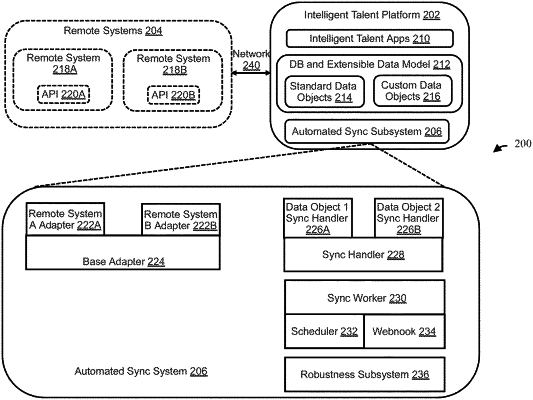| CPC G06F 16/27 (2019.01) [G06F 16/2365 (2019.01); H04L 67/1095 (2013.01)] | 19 Claims |

|
1. A system comprising one or more processing devices and one or more storage devices for storing instructions that when executed by the one or more processing devices to implement an automated synchronization system for an intelligent talent platform, the automated synchronization system comprising:
one or more remote system adapters, each of the one or more remote system adapters being communicatively coupled to a corresponding remote system, to retrieve one or more first data objects containing information relating to managing talents;
a synchronization handler to:
obtain, based on identification features of the one or more first data objects, one or more second data objects from a storage device associated with the intelligent talent platform;
calculate a consistency score based on values in the one or more first data objects and values in the one or more second data objects; and
responsive to determining that the one or more first data objects comprise modifications from the one or more second data objects based on the consistency score, determine priority values associated with the modifications to the one or more first data objects based on historical modification activities to the one or more first data objects, wherein to determine the priority values based on historical modification activities to the one or more first data objects, the synchronization handler is further to:
determine the historical modification activities comprising a list of inactive and dispositioned first data objects that have since had a subsequent modification;
calculate a corresponding statistic metric for each first data object in the list based on a time elapsed from a first data object in the list made inactive and dispositioned to when the first data object had a modification; and
calculate a corresponding priority value for each of the first data objects based on a comparison between a statistic metric of the first data object with the corresponding statistic metric calculated for each of the first data objects in the list;
a scheduler to generate a synchronization schedule based on the priority values; and
a synchronization worker to execute data synchronization between the one or more first data objects and the one or more second data objects in accordance with the synchronization schedule.
|